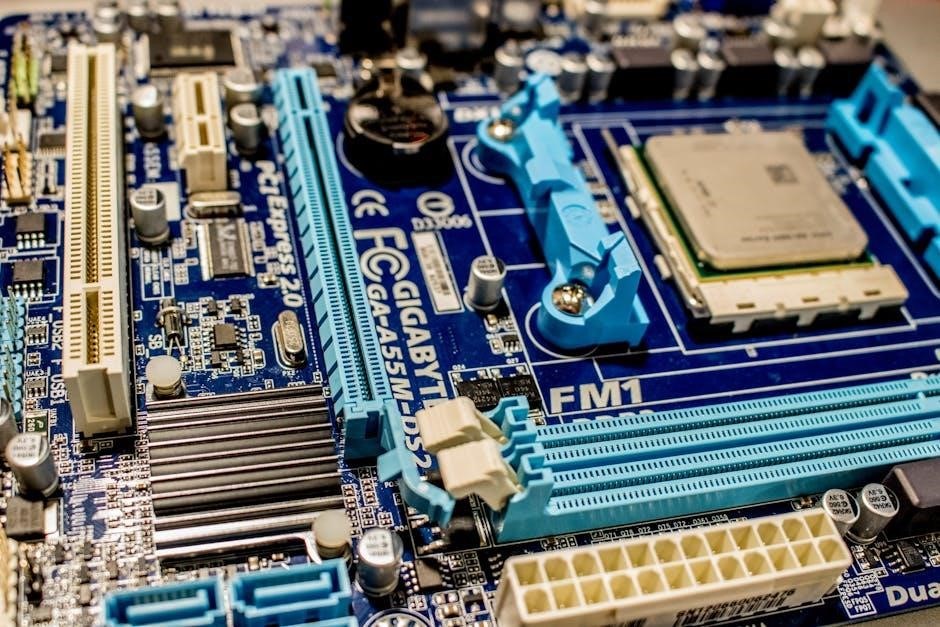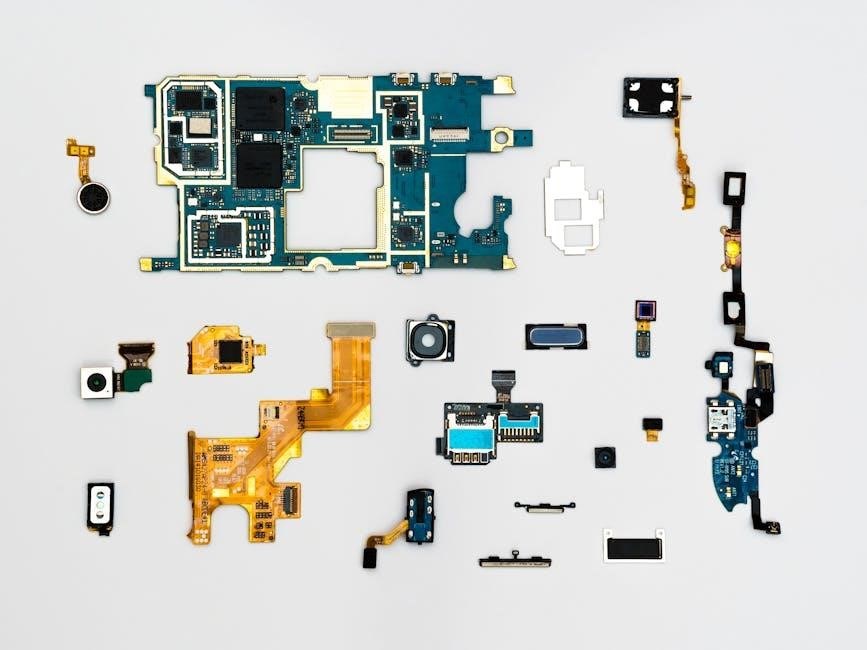Electrical engineering handbooks are essential resources‚ offering comprehensive guides on circuits‚ power systems‚ and emerging technologies. They serve as indispensable tools for professionals and students‚ evolving from print to digital formats to meet modern demands.
1.1 Purpose and Scope of Electrical Engineering Handbooks
Electrical engineering handbooks serve as comprehensive guides for professionals and students‚ providing detailed information on fundamental concepts‚ practical applications‚ and industry standards. Their purpose is to offer a centralized resource for solving engineering problems‚ designing systems‚ and understanding emerging technologies. The scope covers a wide range of topics‚ from electrical circuits and power systems to telecommunications and renewable energy. These handbooks are designed to bridge theory and practice‚ ensuring engineers stay updated with the latest advancements and best practices. They are indispensable for troubleshooting‚ project planning‚ and adhering to safety and regulatory requirements in various industrial and academic settings.
1.2 Key Features of a Comprehensive Electrical Engineering Handbook
A comprehensive electrical engineering handbook typically includes detailed chapters on fundamental concepts‚ such as circuits‚ power systems‚ and control systems. It also covers specialized topics like telecommunications‚ renewable energy‚ and automation. Key features often involve practical application guides‚ case studies‚ and troubleshooting sections. Many handbooks are designed with clear indexing and cross-references for easy navigation. They may also incorporate visual aids like diagrams‚ charts‚ and tables to enhance understanding. Additionally‚ modern handbooks offer digital formats‚ such as PDFs‚ ensuring accessibility and convenience. Regular updates and revisions are crucial to keep the content aligned with industry advancements and standards‚ making them invaluable resources for engineers.
1.3 Why Electrical Engineers Rely on Handbooks
Electrical engineers rely on handbooks for quick access to essential information‚ enabling efficient problem-solving. These resources provide standardized data‚ formulas‚ and best practices‚ ensuring accuracy and compliance with industry standards. Handbooks cover a wide range of topics‚ from fundamental principles to advanced applications‚ making them versatile tools for both students and professionals; Their structured format allows engineers to rapidly locate specific details‚ saving time during critical projects. Additionally‚ handbooks often include practical examples and case studies‚ offering real-world insights. The availability of handbooks in digital formats further enhances accessibility‚ allowing engineers to reference them anytime‚ anywhere‚ and stay updated with the latest technological advancements.

Evolution of Electrical Engineering Handbooks
Electrical engineering handbooks have evolved from bulky print editions to digital formats‚ offering updated content and enhanced accessibility to meet the demands of modern engineering practices.
2.1 Historical Development of Electrical Engineering Handbooks
Electrical engineering handbooks have undergone significant transformations since their inception‚ transitioning from bulky print editions to streamlined digital formats. Early editions focused on fundamental principles‚ while modern versions incorporate advanced topics like renewable energy and automation. The shift to PDF formats has enhanced accessibility‚ allowing engineers to access critical information effortlessly. These handbooks have historically served as indispensable resources‚ providing detailed insights into electrical systems‚ power distribution‚ and measurement techniques. Over time‚ they have adapted to technological advancements‚ ensuring relevance in a rapidly evolving field. This historical development reflects the dynamic nature of electrical engineering and its reliance on comprehensive reference materials.
2.2 From Print to Digital: The Transition of Handbooks
The transition of electrical engineering handbooks from print to digital formats has revolutionized accessibility and convenience. Traditional print handbooks‚ often bulky and cumbersome‚ have been replaced by portable PDF versions. Digital handbooks‚ such as the Standard Handbook for Electrical Engineers (17th Edition) and The Electronics Handbook‚ Second Edition‚ offer comprehensive coverage of electrical engineering topics. Platforms like LitRes provide easy downloads‚ enabling engineers to access critical information anytime‚ anywhere. This shift has enhanced usability‚ with features like search functions and cross-referencing‚ making digital handbooks indispensable for modern practitioners. The move to digital ensures handbooks remain relevant in an increasingly tech-driven field.
2.3 Updates and Revisions in Modern Editions
Modern editions of electrical engineering handbooks are regularly updated to reflect advancements in technology and industry standards. The 17th Edition of the Standard Handbook for Electrical Engineers‚ for instance‚ incorporates the latest developments in smart grid technologies and renewable energy systems. Revisions ensure that handbooks remain aligned with current practices‚ addressing emerging topics like AI integration and sustainable engineering. Digital formats further enhance accessibility‚ with hyperlinks and interactive content improving user experience. These updates are crucial for both students and professionals‚ providing them with accurate and relevant information to meet the demands of a rapidly evolving field.

Core Subjects Covered in Electrical Engineering Handbooks
Electrical engineering handbooks cover core subjects like circuits‚ power systems‚ control systems‚ and measurements. They also include emerging areas such as renewable energy and smart grids‚ providing both theoretical foundations and practical applications essential for modern engineering challenges.
3.1 Fundamentals of Electrical Circuits and Systems
Electrical engineering handbooks provide in-depth coverage of circuit fundamentals‚ including voltage‚ current‚ resistance‚ and Ohm’s Law. They explore circuit analysis techniques‚ such as Kirchhoff’s Laws‚ nodal analysis‚ and mesh analysis. The basics of series‚ parallel‚ and AC/DC circuits are thoroughly explained‚ along with energy storage elements like capacitors and inductors. Transformers‚ impedance‚ and resonance are also key topics. These handbooks emphasize the importance of circuit theorems‚ such as Thevenin’s and Norton’s‚ for simplifying complex networks. Additionally‚ they cover system analysis using phasors and Laplace transforms‚ providing a solid foundation for understanding circuit behavior in various engineering applications. Practical examples and problems are often included.
3.2 Power Engineering and Distribution Systems
Electrical engineering handbooks dedicate extensive sections to power systems‚ detailing the principles of power generation‚ transmission‚ and distribution. They cover the design and operation of power grids‚ including substations‚ transformers‚ and transmission lines. Key topics include voltage regulation‚ power factor correction‚ and load management. The handbooks also address power quality issues‚ such as harmonic distortion and voltage sag‚ and their mitigation techniques. Additionally‚ they provide insights into modern power distribution systems‚ including smart grids‚ renewable energy integration‚ and microgrids. Practical calculations and case studies are often included to help engineers optimize power systems for efficiency and reliability. These resources are essential for power engineers.
3.3 Control Systems and Automation
Control systems and automation are central to modern electrical engineering‚ enabling precise regulation of industrial processes. Handbooks detail the fundamentals of control systems‚ including feedback mechanisms‚ stability analysis‚ and system dynamics. They explore various control strategies‚ such as PID controllers‚ fuzzy logic‚ and model predictive control. Automation techniques‚ including SCADA systems and programmable logic controllers (PLCs)‚ are also covered. These resources provide practical guidance on designing and implementing control systems for industrial applications. They also address emerging technologies like IoT-enabled automation and AI-driven control systems‚ offering engineers the tools to optimize performance‚ reliability‚ and efficiency in automated environments. These insights are invaluable for system design and troubleshooting.
3.4 Electrical Measurements and Signal Processing
Electrical measurements and signal processing are essential for accurate data acquisition and analysis in electrical engineering. Handbooks provide detailed methods for measuring voltage‚ current‚ resistance‚ and power‚ emphasizing precision and safety. They cover advanced tools like digital multimeters‚ oscilloscopes‚ and sensors. Signal processing techniques‚ including filtering‚ Fourier transforms‚ and convolution‚ are explained to enhance signal quality and extract valuable information. Practical applications in communication systems‚ control systems‚ and power engineering are highlighted. These resources also address modern software tools for data analysis‚ enabling engineers to interpret and apply measurement data effectively. This section bridges theory and practice‚ ensuring reliable system design and troubleshooting.

Specialized Topics in Electrical Engineering Handbooks
Specialized topics cover advanced areas like telecommunications‚ wireless systems‚ electronics‚ and renewable energy‚ providing in-depth insights and practical applications for modern electrical engineering challenges and innovations.
4.1 Telecommunications and Wireless Systems
Telecommunications and wireless systems are critical components of modern electrical engineering‚ focusing on signal transmission‚ network design‚ and wireless communication technologies. This section covers the fundamentals of radio frequency (RF) engineering‚ antenna design‚ and modulation techniques. It also explores advanced topics like 5G networks‚ Wi-Fi systems‚ and satellite communications. Key concepts such as signal processing‚ noise reduction‚ and data compression are addressed to ensure reliable and high-speed communication. Emerging technologies like IoT (Internet of Things) and Li-Fi are also discussed‚ providing insights into future trends. Practical applications and design considerations make this section invaluable for engineers working in telecommunications and wireless domains.
4.2 Electronics and Semiconductor Devices
This section delves into the principles and applications of electronic circuits and semiconductor devices‚ essential for modern electrical engineering. It covers transistor theory‚ diode operation‚ and integrated circuit design. Key topics include semiconductor materials‚ device fabrication‚ and circuit analysis. The handbook explores advanced devices like MOSFETs‚ thyristors‚ and optoelectronic components. Practical aspects such as amplifiers‚ filters‚ and power electronics are discussed‚ along with emerging technologies like MEMS and nanoelectronics. The role of semiconductors in revolutionizing electronics is highlighted‚ emphasizing their impact on communication‚ computing‚ and industrial systems. This section provides engineers with a comprehensive understanding of electronic devices and their applications in real-world scenarios.
4.3 Renewable Energy Systems and Sustainability
This section focuses on renewable energy systems and sustainable practices in electrical engineering. It explores solar‚ wind‚ and hydro energy technologies‚ emphasizing their integration into power systems. Key topics include energy storage solutions‚ such as batteries‚ and grid-tied renewable energy systems. The handbook discusses sustainable design principles and energy efficiency optimization. It also addresses the role of smart grids and microgrids in supporting renewable energy distribution. Case studies highlight successful implementations of renewable energy projects‚ providing practical insights. The section underscores the importance of reducing carbon footprints and promoting eco-friendly electrical engineering practices for a sustainable future.

Application Guides for Practitioners
These guides provide practical insights for electrical engineers‚ offering real-world solutions and industry-specific advice for design‚ installation‚ and problem-solving in various engineering scenarios.
5.1 Handbook for Electrical Engineers in the Oil‚ Gas‚ and Petrochemical Industry
This specialized handbook addresses the unique challenges faced by electrical engineers in the oil‚ gas‚ and petrochemical sectors. It covers safety standards‚ hazardous area classifications‚ and equipment specifications for explosive environments. The guide provides detailed insights into power distribution systems‚ control systems‚ and instrumentation tailored for industrial plants. It also includes best practices for maintaining electrical systems in harsh conditions‚ ensuring reliability and compliance with industry regulations. Case studies and practical examples highlight real-world applications‚ making it an indispensable resource for professionals working in these demanding fields. The handbook emphasizes the importance of adherence to international standards and safety protocols to prevent accidents and ensure operational efficiency.
5.2 Electrical Engineering Practices in Industrial Automation
This section focuses on the electrical engineering practices essential for industrial automation‚ emphasizing the design‚ installation‚ and maintenance of automated systems. It covers control systems‚ motor drives‚ and programmable logic controllers (PLCs)‚ providing practical guidance on integrating electrical components with automation technologies. The handbook includes best practices for safety‚ wiring‚ and troubleshooting in industrial environments. It also addresses the importance of adhering to industry standards for automation systems‚ ensuring reliability and efficiency; Case studies illustrate real-world applications‚ while tables and diagrams offer quick reference for engineers working on industrial automation projects. This resource is invaluable for professionals seeking to optimize industrial processes through advanced electrical engineering practices.

Practical Implementation and Case Studies
This section bridges theory and practice‚ showcasing real-world applications of electrical engineering principles in industrial and commercial settings through detailed case studies and problem-solving examples.
6.1 Real-World Applications of Handbook Knowledge
Electrical engineering handbooks provide practical insights into designing‚ analyzing‚ and optimizing electrical systems. Engineers apply this knowledge in power distribution‚ circuit design‚ and automation. For instance‚ handbook formulas and charts aid in calculating load requirements‚ ensuring efficient system performance. Case studies in handbooks demonstrate how to troubleshoot issues like voltage drops or harmonic distortions. Real-world examples include implementing renewable energy systems‚ designing industrial control panels‚ and upgrading grid infrastructure. These applications highlight how handbook knowledge directly translates into solving engineering challenges‚ ensuring safety‚ reliability‚ and compliance with industry standards. This makes handbooks indispensable tools for both novice and experienced electrical engineers in diverse sectors.
6.2 Troubleshooting Common Electrical Engineering Challenges
Electrical engineering handbooks are invaluable for addressing common challenges like short circuits‚ ground faults‚ and voltage fluctuations; They provide systematic approaches to diagnose issues‚ such as using circuit diagrams and test procedures. For example‚ handbooks often include troubleshooting guides for motors‚ transformers‚ and control systems. Engineers can identify faulty components or misconfigurations by referencing tables and formulas. Step-by-step solutions and case studies help resolve issues efficiently. These resources are particularly useful in industrial settings‚ where downtime must be minimized. By leveraging handbook knowledge‚ engineers can ensure system reliability‚ safety‚ and optimal performance‚ making these guides essential for problem-solving in the field.

Editions and Formats of Electrical Engineering Handbooks
Modern handbooks are available in various editions and formats‚ including print‚ digital‚ and portable versions‚ catering to different learning and practical needs of engineers and students.
7.1 Standard Handbook for Electrical Engineers (13th Edition)
The 13th Edition of the Standard Handbook for Electrical Engineers is a comprehensive reference guide‚ widely regarded as a cornerstone for professionals and students. It covers fundamental theories‚ practical applications‚ and emerging technologies in electrical engineering. Updated with the latest industry standards and advancements‚ this edition includes detailed sections on power systems‚ control systems‚ and telecommunications. It provides in-depth analysis of circuit design‚ transmission lines‚ and electromagnetic fields. The handbook also incorporates practical data‚ such as charts‚ tables‚ and formulas‚ making it an indispensable tool for solving real-world problems. Its availability in both print and digital formats‚ including PDF‚ ensures accessibility for modern engineers.
7.2 The Electronics Handbook‚ Second Edition
The Electronics Handbook‚ Second Edition‚ is a leading reference for electrical engineers‚ offering in-depth coverage of electronic circuits‚ devices‚ and systems. This edition includes updated chapters on emerging technologies like nanotechnology‚ IoT‚ and renewable energy. It provides detailed explanations of semiconductor physics‚ electronic design automation‚ and communication systems. Practical examples‚ equations‚ and design methodologies make it a valuable resource for both academic and professional use. The handbook also features contributions from renowned experts‚ ensuring high-quality content. Its availability in formats such as PDF enhances accessibility‚ making it a versatile tool for engineers seeking to stay updated with the latest advancements in electronics.
7.3 Portable Handbook for Electrical Engineers
The Portable Handbook for Electrical Engineers is designed for on-the-go professionals‚ offering concise yet comprehensive coverage of essential topics. It focuses on practical applications‚ including circuit design‚ power systems‚ and control systems. The handbook is compact‚ making it easy to carry‚ while still providing detailed formulas‚ charts‚ and tables. Key areas include electrical safety‚ wiring practices‚ and troubleshooting techniques. Its digital format‚ such as PDF‚ enhances accessibility across devices. This handbook is ideal for fieldwork‚ providing quick reference solutions to common challenges. It serves as a reliable companion for engineers needing immediate‚ actionable information in dynamic work environments.

Standardization and Compliance
Standardization and Compliance ensure electrical systems meet safety‚ efficiency‚ and reliability requirements. Compliance with international codes and regulations is crucial for legal and operational integrity.
8.1 Industry Standards and Codes in Electrical Engineering
Industry standards and codes are essential for ensuring safety‚ reliability‚ and compatibility in electrical engineering. Organizations like IEEE‚ IEC‚ and NEC establish guidelines for design‚ installation‚ and operation. These standards cover circuit design‚ wiring‚ and equipment safety‚ ensuring compliance with legal and operational requirements. For example‚ IEC 60906 defines plug socket standards‚ while NEC ensures electrical safety in the U.S. Adhering to these codes minimizes risks and facilitates global interoperability. Electrical engineering handbooks often include detailed references to these standards‚ providing engineers with a comprehensive resource for compliant and efficient system design. They serve as a cornerstone for ethical and professional practice in the field.
8.2 Compliance with International Electrical Standards
Compliance with international electrical standards ensures global harmonization‚ safety‚ and efficiency. Organizations like IEC and IEEE develop standards that guide electrical engineering practices worldwide. These standards address voltage‚ frequency‚ and safety protocols‚ ensuring equipment compatibility and minimizing risks. Engineers rely on handbooks to navigate these regulations‚ as they provide detailed guidelines for design‚ testing‚ and implementation. Compliance also facilitates international trade by enabling manufacturers to meet diverse market requirements. Regular updates to these standards reflect technological advancements‚ ensuring practices remain current and aligned with global trends. Adhering to international standards is crucial for maintaining professionalism and public trust in electrical engineering projects.

The Role of Digital Formats in Modern Engineering
Digital formats enhance accessibility‚ convenience‚ and efficiency in modern engineering‚ offering instant access to updated information and multimedia resources‚ aligning with evolving technological demands.
9.1 Advantages of PDF Formats for Electrical Engineering Handbooks
The PDF format offers significant advantages for electrical engineering handbooks‚ including portability‚ preservation of complex formatting‚ and universal accessibility across devices. Engineers benefit from the ability to carry entire handbooks on laptops or tablets‚ ensuring quick reference in diverse settings. PDFs maintain precise layouts‚ crucial for technical diagrams and equations‚ and support embedded hyperlinks for easy navigation. Search functionality allows rapid access to specific topics‚ enhancing productivity. Additionally‚ PDFs are secure‚ with encryption options to protect sensitive content‚ and are compatible with all operating systems‚ making them a versatile and reliable choice for modern engineers relying on digital resources.
9.2 Accessibility and Convenience of Digital Handbooks
Digital handbooks offer unparalleled accessibility and convenience‚ enabling electrical engineers to access critical information anytime‚ anywhere. With cloud-based storage‚ handbooks can be retrieved from any device‚ eliminating the need for physical copies. Engineers can quickly search for specific topics using built-in search functions‚ saving time during urgent projects. Digital formats also reduce clutter‚ as entire libraries can be stored on a single device. Additionally‚ hyperlinks and cross-references within digital handbooks streamline navigation‚ while zoom and night-mode features enhance readability. This convenience makes digital handbooks indispensable for modern engineers‚ ensuring they remain productive in both office and field environments.

Resources for Electrical Engineers
Discover essential resources‚ including online libraries and platforms offering downloadable electrical engineering PDFs‚ to enhance your knowledge and practical skills in the field.
10.1 Recommended Electrical Engineering Handbooks and Guides
For electrical engineers‚ essential handbooks include the Standard Handbook for Electrical Engineers and The Electronics Handbook. These resources provide in-depth coverage of circuits‚ power systems‚ and emerging technologies. Additionally‚ Electric Power Generation‚ Transmission‚ and Distribution is invaluable for understanding energy systems. Engineers can access these handbooks in PDF formats through platforms like IEEE Xplore or academic libraries. Regularly updated editions ensure alignment with industry advancements. These guides are indispensable for both students and professionals‚ offering practical insights and theoretical foundations to tackle complex engineering challenges effectively. They serve as comprehensive references for designing‚ analyzing‚ and optimizing electrical systems.
10.2 Online Platforms for Downloading Electrical Engineering PDFs
Several online platforms provide access to electrical engineering PDFs‚ including handbooks and guides. IEEE Xplore and ScienceDirect offer extensive libraries of technical publications‚ while SpringerLink features e-books on specialized topics. ResearchGate and Academia.edu allow researchers to share and download relevant materials. Google Scholar is another valuable resource for locating free PDFs of electrical engineering handbooks. Many platforms require subscriptions or institutional access‚ but some offer free downloads. Always ensure compliance with copyright and licensing agreements when accessing these resources. These platforms are essential for engineers seeking convenient access to high-quality educational and reference materials.
The Future of Electrical Engineering Handbooks
The future of electrical engineering handbooks lies in AI-driven‚ interactive formats‚ offering real-time updates and personalized learning experiences for engineers worldwide.
11.1 Emerging Trends in Electrical Engineering
Emerging trends in electrical engineering include advancements in renewable energy systems‚ smart grid technologies‚ and the integration of AI in power systems. These innovations are driving the need for updated handbooks that incorporate sustainable practices and intelligent systems. The shift toward electric vehicles and energy storage solutions is also reshaping the field‚ requiring engineers to adapt quickly. Additionally‚ the rise of IoT and 5G networks is creating new opportunities for electrical engineers to design more efficient and connected systems. These trends highlight the importance of handbooks that provide cutting-edge information and practical applications to help engineers stay competitive in a rapidly evolving industry.
11.2 Integrating AI and Machine Learning into Handbook Resources
The integration of AI and machine learning into handbook resources is revolutionizing electrical engineering education and practice. AI-driven tools now enable personalized learning paths‚ adaptive simulations‚ and real-time problem-solving assistance. Machine learning algorithms can analyze complex systems‚ predict failures‚ and optimize designs. Handbooks are increasingly incorporating AI-generated content‚ such as dynamic circuit simulations and automated calculations. These advancements enhance accessibility and efficiency‚ allowing engineers to solve problems faster. AI also enables handbooks to provide real-time updates and interactive examples‚ making them indispensable for both students and professionals. This integration ensures that handbooks remain relevant and effective in addressing modern electrical engineering challenges.
